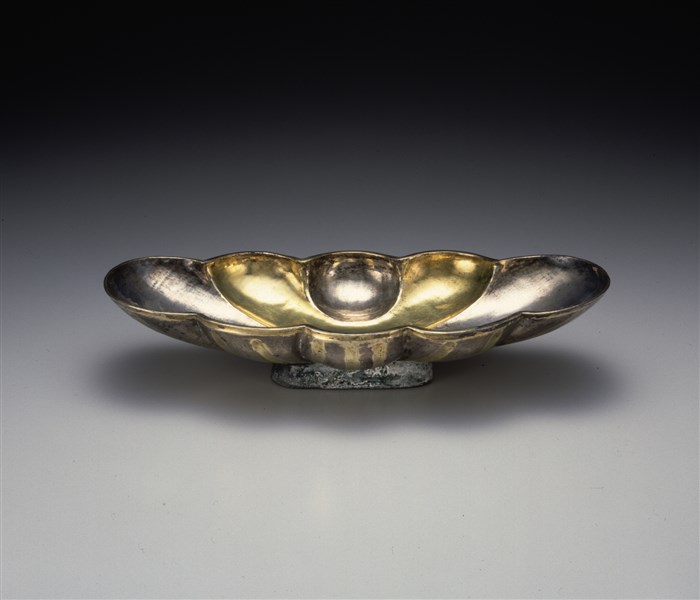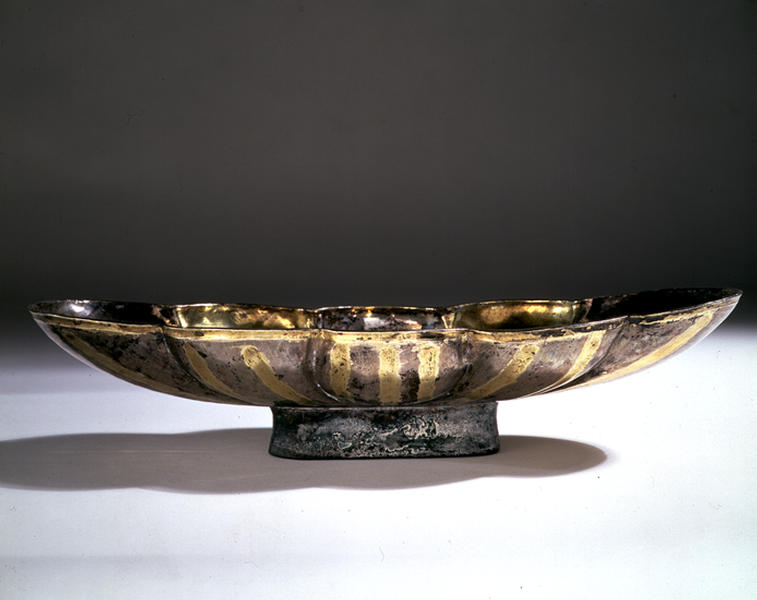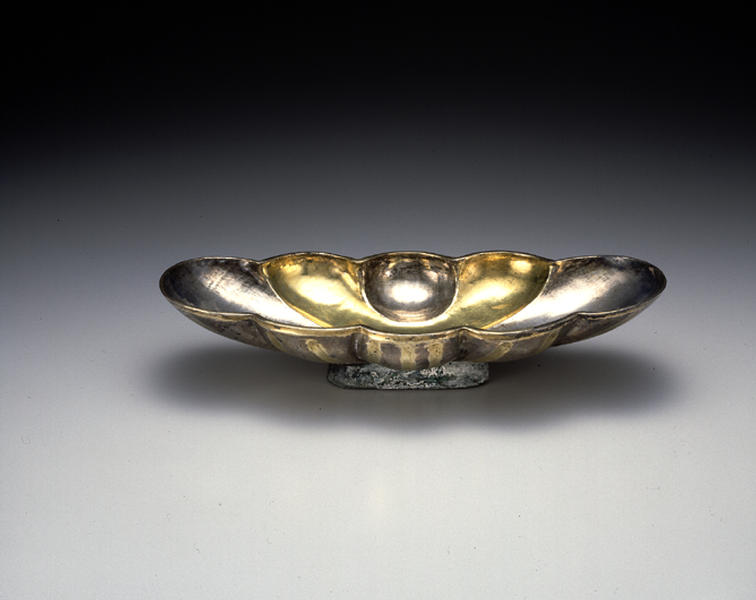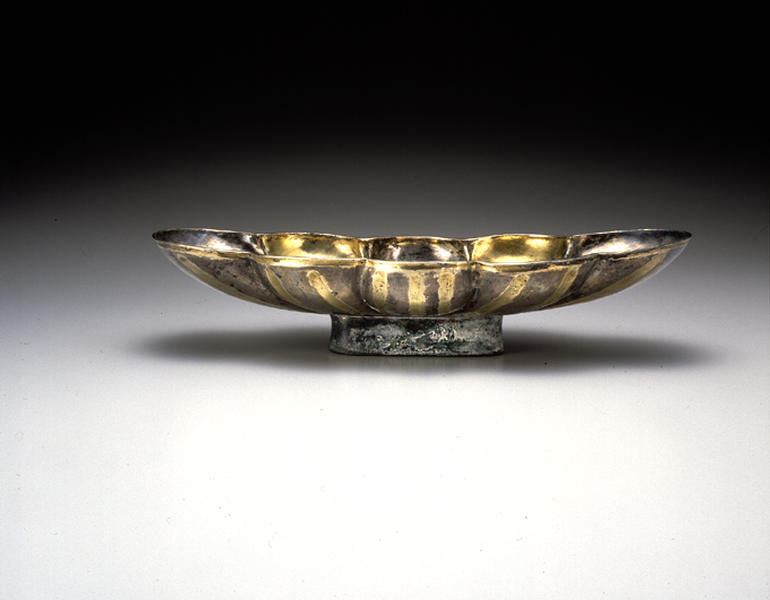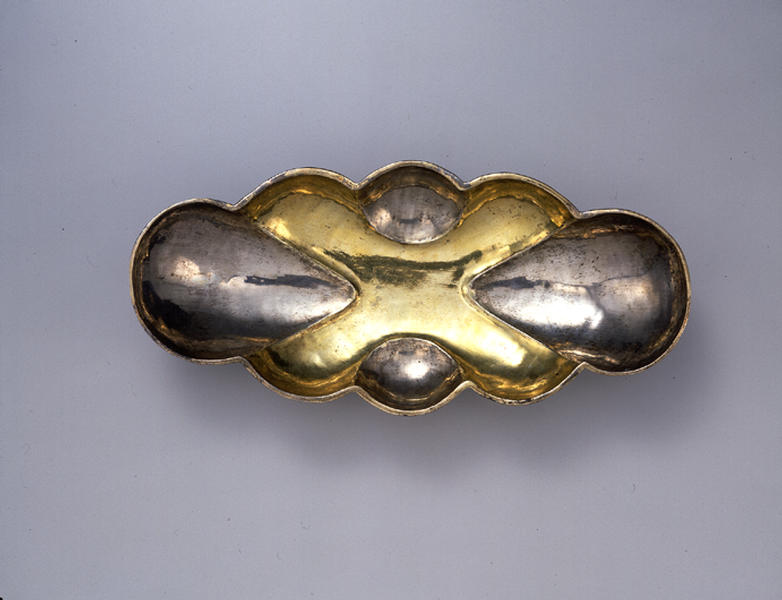八曲杯
- イラン
- ササン朝ペルシア
- 4-5世紀
- 鍍金銀
- D-29 W-13
解説(開館1周年記念展)
この脚付の杯は,楕円形の器の口縁を八曲に造り,長軸の両端に涙滴状の窪み,短軸の両端に四分球状の窪み,そしてその間の部分はつながって太いX字状の窪みを造りだしている。この内面のX字状部分,外面の口縁にそって細く帯状に彫り込まれた部分に鍍金が施され,外面に浅く放射状に削り出された溝にも鍍金が施されている。
通常,八曲杯は,長軸にそって溝が付けられていることをもってその器の特徴とされているが,このような求心的な意匠も多く見られる。当作品と類似の形式のものがクリーヴランド美術館,天理大学附属天理参考館にある。*1 スイスのアベッグ・スティフトゥング・コレクション,ワシントン・サックラー・ギャラリーには,おのおの八つの窪みが独立して,菊花状に窪みをもった器を細長く引き延ばした形に造りだされた作例があり,これらと同形式でインド,パキスタン地域の作と見られる器が中国の大同から発掘されている。*2
この八曲長杯の起源については,ローマ時代の貝殻形容器を開いた時の形に由来するという説がある。*3 一方でローマ時代には菊花状に口縁を曲げ,花弁状に窪みを施した器も多く作られた。*4 同時代のペルシアでは同時に舟形長杯が流布し脚付の器も作られたが,この舟形長杯の形式にこれらローマの花弁状の窪みをもった器の意匠が適応された可能性も考えられる。
1 The Cleveland Museum of Art, John L. Severance Fund, 63.478; 大阪市立美術館/天理秘蔵名品展/大阪1992
2 Koninklijke Musea voor Kunst en Geschiedenis/Hofkunst van de Sassanieden/Brussel 1993; 朝日新聞社/文化大革命中の中国出土文物/東京1973
3 深井晋司/ペルシャ古美術研究1/東京1967
4 Antikenmuseum Berlin, Misc 3779; Inv 30481
Catalogue Entry
This footed cup was fashioned by originally making an oblong cup and then incorporating the eight lobes. On either end of the long axis, the lobe is teardrop-shaped, making a large area of depression in the cup. Similarly, on the either end of the short axis, the lobe makes a circular depression on the inside of the vessel. As a result, the remaining four lobes of the cup, if viewed from the top, form an X-shaped area of depression. This X-shaped area, as well as the small border around the lip of the vessel, is gilded with gold. Also gilded are the grooves radiating from where the cup joins the base.
Ordinarily, eight-lobed cups are characterized as having a deep depression running alongside the long axis of the vessel, but examples having a centripetal design like the present work have also been known. Works similar to this cup are owned by the Cleveland Museum of Art in the United States and the Tenri University Sankokan Museum.*1 Examples now among the Abegg-stiftung Collection in Switzerland and the collection of the Sackler Gallery in Washington, D.C. offer a type in which each of the eight lobes is made into an independent depression, visually analogous to a chrysanthemum flower, and then the elliptical shape is made, as it were, by pulling on two ends. Further, a vessel having the same stylistic features and probably made in the India/Pakistan area has been discovered in Datong, China.*2
As for the origin of elliptical eight-lobed cups, some consider that they imitate the open, shell-shaped vessels prevalent during the Roman era.*3 During this era, lobed vessels with an overall centripetal design, where each petal represented an area of depression and was rounded off at the lip, were widely used.*4 In Persia, too, during the same period, long boat-like cups, some footed were created. Given these developments in areas close to Iran, it is not impossible that this specific type of eight-lobed cup was created on the basic Persian design but incorporated the elements of Roman vessels with a centripetal element.
